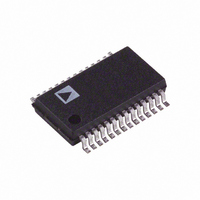AD9761ARSZ Analog Devices Inc, AD9761ARSZ Datasheet - Page 7

AD9761ARSZ
Manufacturer Part Number
AD9761ARSZ
Description
IC DAC 10BIT DUAL 40MSPS 28-SSOP
Manufacturer
Analog Devices Inc
Datasheet
1.AD9761ARSZ.pdf
(24 pages)
Specifications of AD9761ARSZ
Data Interface
Parallel
Settling Time
35ns
Number Of Bits
10
Number Of Converters
2
Voltage Supply Source
Analog and Digital
Power Dissipation (max)
250mW
Operating Temperature
-40°C ~ 85°C
Mounting Type
Surface Mount
Package / Case
28-SSOP
Resolution (bits)
10bit
Sampling Rate
40MSPS
Input Channel Type
Parallel
Supply Voltage Range - Analogue
3V To 5.5V
Supply Voltage Range - Digital
2.7V To 5.5V
Supply
RoHS Compliant
Lead Free Status / RoHS Status
Lead free / RoHS Compliant
For Use With
AD9761-EBZ - BOARD EVAL FOR AD9761
Lead Free Status / RoHS Status
Lead free / RoHS Compliant
Available stocks
Company
Part Number
Manufacturer
Quantity
Price
Part Number:
AD9761ARSZ
Manufacturer:
ADI/亚德诺
Quantity:
20 000
DEFINITIONS OF SPECIFICATIONS
Linearity Error
(Also Called Integral Nonlinearity or INL)
Linearity error is defined as the maximum deviation of the
actual analog output from the ideal output, determined by a
straight line drawn from zero to full scale.
Differential Nonlinearity (DNL)
DNL is the measure of the variation in analog value, normalized
to full scale, associated with a 1 LSB change in digital input code.
Monotonicity
A D/A converter is monotonic if the output either increases or
remains constant as the digital input increases.
Offset Error
The deviation of the output current from the ideal of zero is
called offset error. For IOUTA, 0 mA output is expected when
the inputs are all 0s. For IOUTB, 0 mA output is expected when
all inputs are set to 1s.
Gain Error
The difference between the actual and ideal output span. The
actual span is determined by the output when all inputs are set to
1s minus the output when all inputs are set to 0s.
Output Compliance Range
The range of allowable voltage at the output of a current-output
DAC. Operation beyond the maximum compliance limits may
cause either output stage saturation or breakdown, resulting in
nonlinear performance.
Temperature Drift
Temperature drift is specified as the maximum change from the
ambient (25°C) value to the value at either T
offset and gain drift, the drift is reported in ppm of full-scale
range (FSR) per °C. For reference drift, the drift is reported in
ppm per °C.
Power Supply Rejection
The maximum change in the full-scale output as the supplies
are varied from nominal to minimum and maximum specified
voltages.
Settling Time
The time required for the output to reach and remain within a
specified error band about its final value, measured from the start
of the output transition.
Glitch Impulse
Asymmetrical switching times in a DAC give rise to undesired
output transients that are quantified by a glitch impulse. It is
specified as the net area of the glitch in pV-s.
REV. C
MIN
or T
MAX
. For
–7–
Channel Isolation
Channel Isolation is a measure of the level of crosstalk between
channels. It is measured by producing a full-scale 8 MHz signal
output for one channel and measuring the leakage into the other
channel.
Spurious-Free Dynamic Range
The difference, in dB, between the rms amplitude of the output
signal and the peak spurious signal over the specified bandwidth.
Total Harmonic Distortion
THD is the ratio of the sum of the rms value of the first six
harmonic components to the rms value of the measured output
signal. It is expressed as a percentage or in decibels (dB).
Signal-to-Noise and Distortion (S/N+D, SINAD) Ratio
S/N+D is the ratio of the rms value of the measured output
signal to the rms sum of all other spectral components below the
Nyquist frequency, including harmonics but excluding dc. The
value for S/N+D is expressed in decibels.
Effective Number of Bits (ENOB)
For a sine wave, SINAD can be expressed in terms of the number
of bits. Using the following formula,
it is possible to get a measure of performance expressed as N, the
effective number of bits.
Thus, effective number of bits for a device for sine wave inputs
at a given input frequency can be calculated directly from its
measured SINAD.
Pass Band
Frequency band in which any input applied therein
passes unattenuated to the DAC output.
Stop-Band Rejection
The amount of attenuation of a frequency outside the pass band
applied to the DAC, relative to a full-scale signal applied at the
DAC input within the pass band.
Group Delay
Number of input clocks between an impulse applied at
the device input and peak DAC output current.
Impulse Response
Response of the device to an impulse applied to the input.
N = (SINAD – 1.76)/6.02
AD9761













